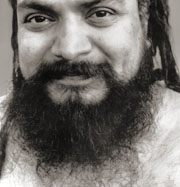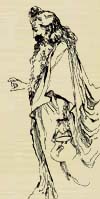Vasishta as a Historical Person
Adapted from the Preface by V. L. Mitra
to his 1891 publication of Yoga Vasishta Maharamayana
The Yoga Vasishta is the earliest work on yoga or speculative and abstruse philosophy delivered by the venerable Vedic sage Vasishta to his royal pupil Rama, the victor of Ravana and hero of the first epic Ramayana, and written in the language of the prime bard, Valmiki, in pure Sanskrit, the author of that popular epic and the Homer of India.
The first record that we have of Vasishta is that he was the author of the 7th Mandala of the Rig Veda (Ashtaka v. 15-118).
He is next mentioned as Purohita or joint minister with Vishwamitra to King Sudasa, and to have a violent contest with his rival for the ministerial office (Müll. Hist. S. Lit. page 486, Web. Id. p. 38). He is said to have accompanied the army of Sudasa, when that king is said to have conquered the ten invading chiefs who had crossed over the river Parushni (Hydroates or Ravi) to his dominions (Müll. Id. p. 486). Vishwamitra accompanied Sudasa himself beyond Vipasa, Hyphasis or Beah and Satadru-Hisaudras-Sutlej (Max Müller, Ancient Sanscrit literature page 486). These events are recorded to have occurred prior to Vasishta’s composition of the Mandala which passes under his name and in which they are recorded. (Müll. Id. p. 486).
The enmity and implacable hatred of the two families of Vasishtas and Vishwamitras for generations, form subjects prominent throughout the Vedic antiquity, and are preserved in the tradition of ages (Mull. Id. p. 486, Web. Id. p. 37).
Another cause of this enmity was that Harischandra, King of Ayodhya, was cursed by Vasishta, whereupon he made Vishwamitra his priest to the annoyance of Vasishta, although the office of Brahmana was held by him (Müller Id. page 408 Web. pp. 31-37).
In the Brahmana period we find Vasishta forming a family title for the whole Vasishta race still continuing as a Gotra name, and that these Vasishtas continued as hereditary Gurus and purohitas to the kings of the solar race from generation to generation under the same title. The Vasishtas were always the brahmins or high priests in every ceremony, which could not be held by other brahmins according to the Sata patha Brahmana (Müll. Id. page 92). Particularly the Indra ceremony had always to be performed by a Vasishta, because it was revealed only to their ancestor, the sage Vasishta (Web. Ind. Lit. p. 123). As the Satapatha Brahmana-Taittiriya Sanhita mentions it. “The Rishis do not see Indra clearly, but Vasishta saw him. Indra said, I will tell you, O Brahmin, so that all men who are born, will have a Vasishta for his Purohita.” (Max Müll. Ans. Sans. Lit. p. 92. Web. Id. p. 123).
This will show that the sloka [couplet verse] works that are attributed to Vasishta, Yajnavalkya or any other Vedic rishi, could not be the composition of the old rishis, but of some one of their posterity; though they might have been propounded by the eldest sages, and then put to writing by oral communication or successive tradition by a distant descendant or disciple of the primitive rishis.
Thus we see the Drahyayana Sutras of the Sama Veda is also called the Vasishta Sutras, from the author’s family name of Vasishta (Web. Id. p. 79).
The Asvalayana Grihya Sutra assigns some other works to Vasishta, viz., the Vasishta pragatha, probably Vasishta Hymni of Bopp; the Pavamanya, Kshudra sukta, Mahasukta, etc. written in the Vedic style.
There are two other works attributed to Vasishta, the Vasishta Sanhita on Astronomy (Web. Id. p. 258) and the Vasishta Smriti on Law (Web. Id. p. 320), which from their compositions in Sanskrit slokas, could not be the language or work of the Vedic rishi, but of some one late member of that family.
Thus our work of Yoga Vasishta has no claim or pretense to being the composition of the Vedic sage; but as one propounded by the sage, and written by Valmiki in his modern Sanskrit.
I must leave for others to determine whether Vasishta the preceptor of Rama was the vedic Vasishta or one of his descendants.
Again in the later Aranyaka period we have an account of a theologian Vasishta given in the Arshik-Upanishad as holding a dialogue on the nature of atma or soul among the sages, Vishwamitra, Jamadagni, Bharadwaja, Gautama and himself; when Vasishta appealing to the opinion of Kapila obtained their assent (Weber Id. p. 162). This appears very probably to be the theological author of our yoga, and eminent above his contemporaries in his knowledge of the Kapila Yoga Shastra which was then current, from this sage’s having been a contemporary with King Sagara, a predecessor of Rama.
In the latest Sútra period we find a passage in the Grihya-Sútra-parisishta about the distinctive mark of the Vasishta family from those of the other parishads or classes of the priesthood. It says: “The Vasishtas wear a braid (lock of hair) on the right side, the Atreyas wear three braids, the Angiras have five braids, the Bhrigus are bald, and all others have a single crest.” (Müller Id. p. 53).
The Karma pradípa says, “The Vasishtas exclude meat from their sacrifice; (Müller A. S. Lit. p. 54), and the color of their dress was white (Id. p. 483).”
Many Vasishtas are named in different works bearing no connection with our author other than having been members of the same family (Müller’s A. S. Lit. p. 44).
Without dilating any longer with further accounts relating to the sage Vasishta of which many more might be gathered from various Shastras, I shall add in the conclusion the following notice which is taken of this work by Professor Monier Williams in his work on Indian Wisdom p. 370. “There is,” says he, “a remarkable work called Vasishta Ramayana or Yoga Vasishta or Vasishta Maharamayana in the form of an exhortation, with illustrative narratives addressed by Vasishta to his pupil the youthful Rama, on the best means of attaining true happiness, and considered to have been composed as an appendage to the Ramayana by Valmiki himself. There is another work of the same nature called the Adhyatma Ramayana which is attributed to Vyasa, and treat of the moral and theological subjects connected with the life and acts of that great hero of Indian history. Many other works are extant in the vernacular dialects having the same theme for their subject which it is needless to notice in this place.”
Vasishta, known as the wisest of sages, like Solomon the wisest of men, and Aurelius the wisest of emperors, puts forth in the first part and in the mouth of Rama the great question of the vanity of the world, which is shown synthetically to a great length from the state of all living existences, the instinct, inclinations, and passions of men, the nature of their aims and objects, with some discussions about destiny, necessity, activity and the state of the soul and spirit. The second part embraces various directions for the union of the individual with the universal Abstract Existence — the Supreme Spirit — the subjective and the objective truth — and the common topics of all speculative philosophy.
Thus says Milton, “The end of learning is to know God.”
So the Persian adage, “Akhiral ilm buad ilmi Khoda.”
Such also the Sanskrit, “Savidya tan matir yaya.”
And the Shruti says, “Yad jnatwa naparan jnanam.” I.e., “It is that which being known, there is nothing else required to be known.”
— V. L. Mitra
![]()

